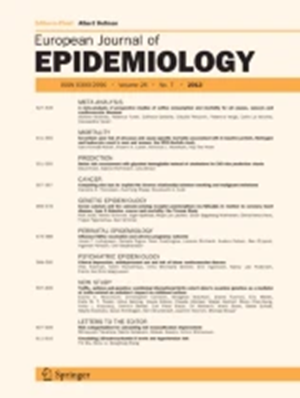Risk tools for predicting long-term sequelae based on symptom profiles after known and undetected SARS-CoV-2 infections in the population.
IF 5.9
1区 医学
Q1 PUBLIC, ENVIRONMENTAL & OCCUPATIONAL HEALTH
引用次数: 0
Abstract
The aim was to determine the profile of long-term symptoms after known and undetected SARS-CoV-2 infections and to generate tools for risk and diagnostic assessment of Post-COVID syndrome (PCS). In the population-based Gutenberg COVID-19 Study (N = 10,250), sequential, systematic screening for SARS-CoV-2 was performed in 2020/2021. Individuals received a standardized interview on newly occurred or worsened symptoms since the infection or the pandemic. Robust Poisson regression models were fit to compare the frequency of symptoms between groups. Two scores were developed using machine learning techniques and prospectively validated in an independent cohort. Among n = 942 individuals, prevalence of long-term symptoms was 36.4% among individuals with known SARS-CoV-2 infection, 25.0% in those unknowingly infected, and 28.1% among the controls. Individuals with known infection more often reported smell (Prevalence ratio [PR] = 13.66 [95% confidence interval 4.99;37.41]) and taste disturbances (PR = 5.57 [2.62;11.81]), forgetfulness (PR = 2.88 [1.55;5.35]), concentration difficulties (PR = 2.83 [1.55;5.16], trouble with balance (PR = 2.74 [1.18;6.35]), and dyspnea (PR = 2.22 [1.18;4.19]) than controls. The risk score for predicting long-term sequelae based on symptoms during the acute infection had a cross-validated AUC of 0.74 and 0.72 when applied in an independent cohort (N = 6,570). The diagnostic score providing a probability of the presence of PCS had a cross-validated AUC of 0.66 and of 0.64 in the validation cohort (N = 3,176). Individuals with and without SARS-COV-2 infection reported persistent symptoms, but symptoms attributable to PCS were identified. The data-driven scores may help guide further diagnostic decisions in the initial management of PCS.基于人群中已知和未发现的SARS-CoV-2感染后的症状特征预测长期后遗症的风险工具。
目的是确定已知和未发现的SARS-CoV-2感染后的长期症状概况,并生成用于后covid综合征(PCS)风险和诊断评估的工具。在基于人群的Gutenberg COVID-19研究(N = 10,250)中,在2020/2021年对SARS-CoV-2进行了顺序的系统筛查。个人接受了关于感染或大流行以来新出现或恶化症状的标准化访谈。采用稳健泊松回归模型比较两组患者的症状发生频率。使用机器学习技术开发了两个分数,并在独立队列中进行了前瞻性验证。在n = 942例个体中,已知感染SARS-CoV-2的个体中长期症状的患病率为36.4%,不知情感染者中为25.0%,对照组中为28.1%。已知感染个体的嗅觉(患病率[PR] = 13.66[95%可信区间4.99;37.41])、味觉障碍(PR = 5.57[2.62;11.81])、健忘(PR = 2.88[1.55;5.35])、注意力集中困难(PR = 2.83[1.55;5.16]、平衡障碍(PR = 2.74[1.18;6.35])和呼吸困难(PR = 2.22[1.18;4.19])比对照组多。在独立队列(N = 6570)中,基于急性感染期间症状预测长期后遗症的风险评分交叉验证的AUC分别为0.74和0.72。在验证队列(N = 3,176)中,提供PCS存在概率的诊断评分的交叉验证AUC分别为0.66和0.64。有和没有SARS-COV-2感染的个体报告了持续症状,但确定了可归因于PCS的症状。数据驱动的评分可能有助于指导PCS初始管理的进一步诊断决策。
本文章由计算机程序翻译,如有差异,请以英文原文为准。
求助全文
约1分钟内获得全文
求助全文
来源期刊

European Journal of Epidemiology
医学-公共卫生、环境卫生与职业卫生
CiteScore
21.40
自引率
1.50%
发文量
109
审稿时长
6-12 weeks
期刊介绍:
The European Journal of Epidemiology, established in 1985, is a peer-reviewed publication that provides a platform for discussions on epidemiology in its broadest sense. It covers various aspects of epidemiologic research and statistical methods. The journal facilitates communication between researchers, educators, and practitioners in epidemiology, including those in clinical and community medicine. Contributions from diverse fields such as public health, preventive medicine, clinical medicine, health economics, and computational biology and data science, in relation to health and disease, are encouraged. While accepting submissions from all over the world, the journal particularly emphasizes European topics relevant to epidemiology. The published articles consist of empirical research findings, developments in methodology, and opinion pieces.
 求助内容:
求助内容: 应助结果提醒方式:
应助结果提醒方式:


